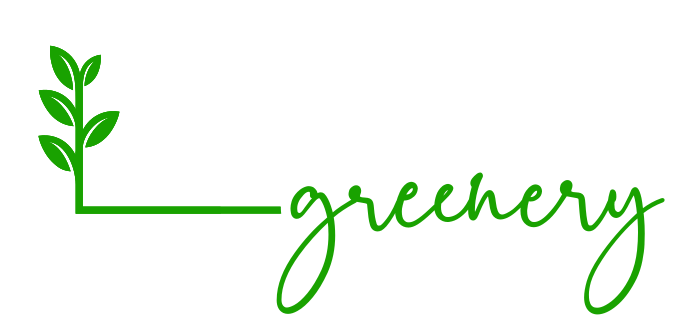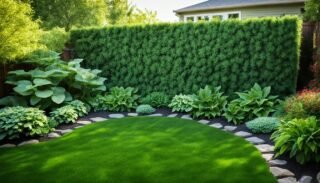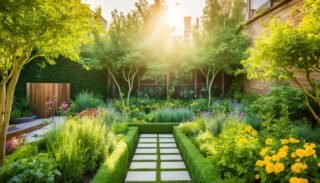Table of Contents
- Introduction to Edible Landscaping: Blending Beauty and Bounty
- The Benefits of Growing Your Own Food at Home
- Planning Your Edible Landscape: Key Considerations
- Fruit Trees: The Cornerstones of Edible Yards
- Edible Landscaping Ideas: Combining Aesthetics and Function
- Herb Gardens: Aromatic and Practical Additions
- Vegetable Beds: From Garden to Table
- Edible Flowers: Adding Color and Flavor to Your Yard
- FAQ
Ever dreamed of picking fresh ingredients for dinner from your own garden? That’s the magic of edible landscaping! I’m excited to show you how to turn your yard into a beautiful and productive oasis.
Edible gardens mix beauty with delicious, home-grown food. By mixing pretty plants with food plants, you get a yard that looks great and feeds your family. Food landscapes are ideal for any outdoor space, big or small.
Productive yards give you more than just veggies. They bring pride, connect you with nature, and teach kids about food. Plus, nothing beats the taste of tomatoes or lettuce you grew yourself!
Key Takeaways
- Edible landscaping combines beauty and functionality in your yard
- Food landscapes offer fresh, home-grown produce right at your doorstep
- Productive yards can be created in spaces of all sizes
- Growing your own food connects you with nature and enhances your meals
- Edible gardens are educational and rewarding for the whole family
Introduction to Edible Landscaping: Blending Beauty and Bounty
I’ve always loved the idea of making my yard both pretty and useful. That’s why I’m excited to talk about edible landscaping. It’s a new way to garden that mixes beauty with food production. This makes gardens that look good and give us fresh food.
Edible landscaping isn’t new. People have grown food in their yards for centuries. Now, we’re adding ornamental edibles to our gardens. These plants are pretty and give us fresh food.
This movement is all about sustainable landscaping. By growing our own food, we help the planet and make our spaces eco-friendly. I love how my edible garden connects me with nature and feeds my family.
Some of my top picks for ornamental edibles are:
- Colorful Swiss chard
- Fragrant herbs like rosemary and thyme
- Fruit trees with beautiful blossoms
- Edible flowers such as nasturtiums
These plants make my yard look great and support a sustainable lifestyle. With edible landscaping, I’ve turned my outdoor space into a garden that feeds and heals me.
The Benefits of Growing Your Own Food at Home
Growing my own food has many benefits. It’s not just about having fresh produce. It’s a way of life that supports organic gardening and sustainable living.
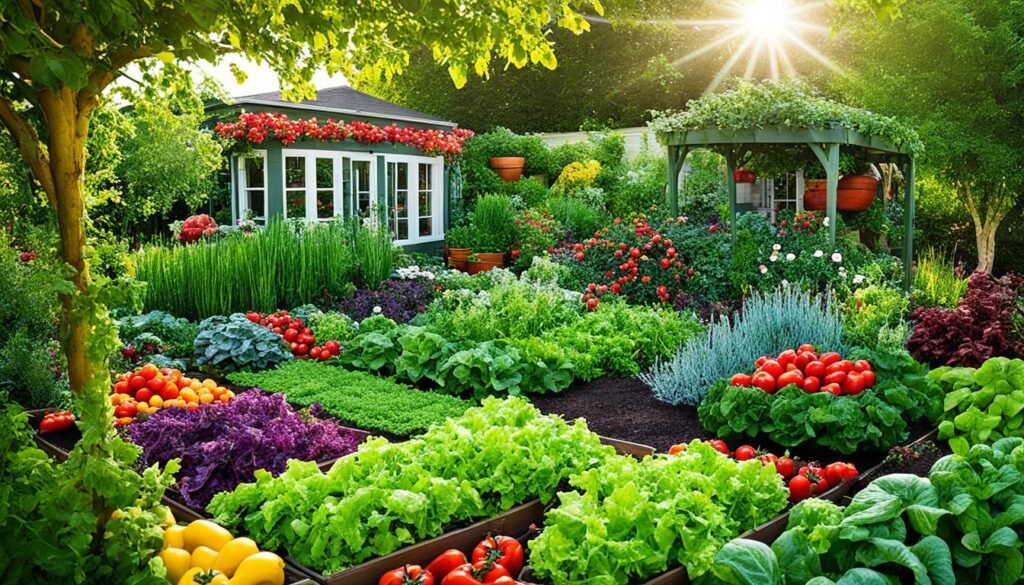
Health Advantages of Fresh Produce
Homegrown fruits and vegetables taste better and are healthier. By growing my own garden, I make sure my family eats food free from pesticides. This leads to better eating habits and health.
Environmental Impact of Edible Landscapes
My edible garden helps the planet. It cuts down on food transport and packaging, reducing my carbon footprint. This way, I’m helping to protect our environment for the future.
Cost Savings on Grocery Bills
Growing my own food has lowered my grocery bills. With a planned garden, I have fresh produce all year. This saves money and makes my family’s food security better.
- Reduced reliance on store-bought produce
- Savings on organic food items
- Potential for preserving and storing excess harvest
By choosing organic gardening and edible landscaping, I’ve made my yard useful and lovely. It’s a fulfilling journey that feeds both my body and soul. It also supports a sustainable lifestyle.
Planning Your Edible Landscape: Key Considerations
I love planning my edible landscape. It’s exciting to imagine a yard full of beautiful, tasty plants. When I start, I focus on three key factors: sunlight, soil, and water.
First, I look at the sunlight in my yard. Most edible plants need at least 6 hours of direct sun daily. I map out sunny and shady spots to guide my plant selection.
Next, I check my soil. Good soil is key for a thriving edible landscape. I test the pH and nutrient levels, then add what’s needed. Sandy soil gets compost for better water retention, while clay soil needs organic matter for better drainage.
Water availability is my third consideration. I plan my garden to make watering efficient. Grouping plants with similar water needs helps me conserve water.
Climate is a big factor in my plant selection. I choose varieties that do well in my local weather. This ensures a good harvest and reduces extra care.
Last, I think about how my edible plants will look with the rest of my landscaping. I use herbs as borders, fruit trees as focal points, and colorful vegetables for visual interest. The result is a beautiful, productive landscape that feeds both body and soul.
Fruit Trees: The Cornerstones of Edible Yards
Fruit trees are key to a backyard orchard, adding beauty and food. They turn ordinary yards into places that produce food. Let’s look at some ways to add fruit trees to your garden.
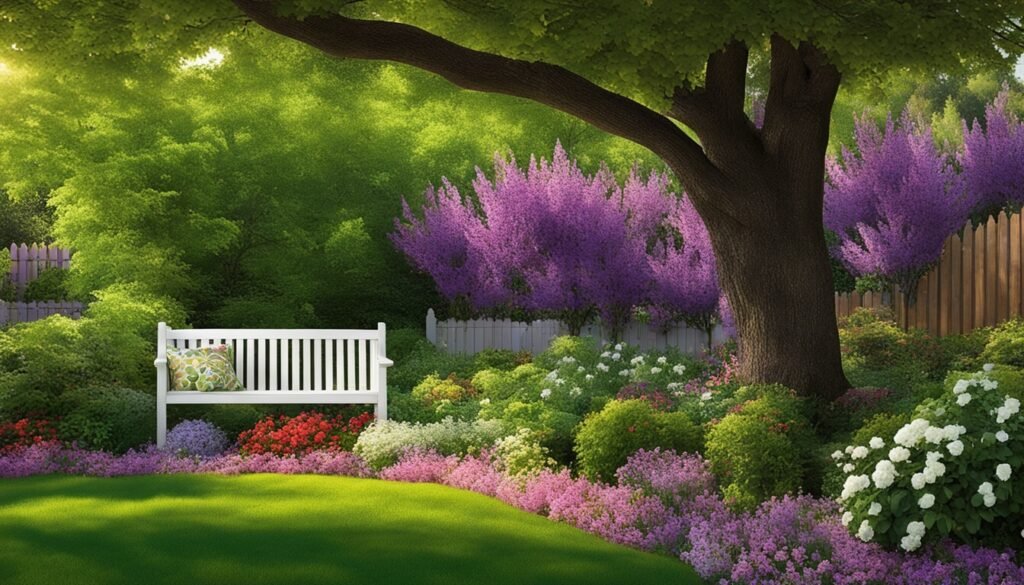
Dwarf Fruit Trees for Small Spaces
For small yards, dwarf fruit trees are ideal. These trees, like apples, peaches, and pears, fit well in containers or small areas. They grow to be 8-10 feet tall, making them easy to care for. You won’t need a ladder for pruning or picking.
Espalier Techniques for Decorative Fruit Trees
Espalier means training trees to grow flat against a wall or fence. It saves space and creates beautiful designs. I’ve espaliered apple and pear trees, making them both pretty and useful.
Best Fruit Tree Varieties for Different Climates
Picking the right fruit tree is key for a successful orchard. Here are my top choices for different areas:
- Cold climates: Hardy apple varieties like ‘Honeycrisp’ or ‘Northern Spy’
- Warm climates: Citrus trees such as lemons, limes, or oranges
- Temperate zones: Stone fruits like peaches, plums, and cherries
For fruit trees to thrive, you need to prune, water, and manage pests. With some work, your garden will be full of tasty fruits.
Edible Landscaping Ideas: Combining Aesthetics and Function
I love making outdoor spaces both beautiful and useful. By mixing ornamental vegetables, edible flowers, and multi-functional plants, you can create a landscape that looks great and tastes good. Let’s dive into some creative ideas to make your yard a treat for the eyes and the taste buds.
Ornamental vegetables add color and texture to your garden beds. I often use vibrant Swiss chard or purple kale as eye-catching border plants. Their colorful leaves make your garden pop and provide nutritious greens for your kitchen.
Edible flowers are great for adding beauty to your garden. I like to sprinkle nasturtiums throughout my garden for bright orange and yellow spots. These peppery blooms are lovely in flower beds and taste great in salads.
Multi-functional plants do more than one job in the garden. Fruit trees offer shade and beautiful blossoms in spring, followed by delicious fruits in summer or fall. I’ve found that dwarf varieties are perfect for smaller yards without losing productivity.
Here are some of my favorite edible landscaping combinations:
- A border of colorful lettuce varieties surrounded by marigolds
- A trellis covered in climbing beans with nasturtiums at the base
- An herb spiral featuring both culinary and ornamental varieties
- A mixed bed of rainbow carrots, purple cabbage, and calendula flowers
By thoughtfully combining these elements, you can create a yard that’s not only beautiful but also provides fresh, homegrown produce all season. The key is to experiment and find what works best in your unique space.
Herb Gardens: Aromatic and Practical Additions
I adore adding herb gardens to my yard. They look great and are super useful. Culinary herbs add fresh flavors to my meals and make my garden smell amazing. Let’s check out some cool ways to add herbs to your yard.

Vertical Herb Gardens for Small Spaces
Got limited space? No worries! Vertical herb gardens are a lifesaver. I use wall-mounted planters or tiered stands to grow herbs in a small spot. My top pick is a herb spiral, which lets different herbs thrive in unique spots. It looks great and works super well!
Culinary Herb Combinations for Cooking Enthusiasts
I’m a big fan of mixing culinary herbs together. My top picks are basil, oregano, thyme, and rosemary. These herbs are perfect together in the garden and in my recipes. I keep them in container gardens near my kitchen for easy reach while cooking.
Medicinal Herbs to Include in Your Landscape
I’ve also added medicinal herbs to my garden. Chamomile, echinacea, and peppermint are my go-tos. They’re great for health and make my garden more interesting. I often dry these herbs for tea or use them fresh in my remedies.
Herb gardens are perfect for anyone, whether you’re an expert or a beginner. They’re low-maintenance, smell incredible, and give you fresh ingredients right in your yard. Try it out and see how much happiness a small herb garden can bring!
Vegetable Beds: From Garden to Table
I love growing my own vegetables. It’s rewarding and brings fresh produce right to my table. Raised beds are perfect for this, offering better soil control and easy harvesting.
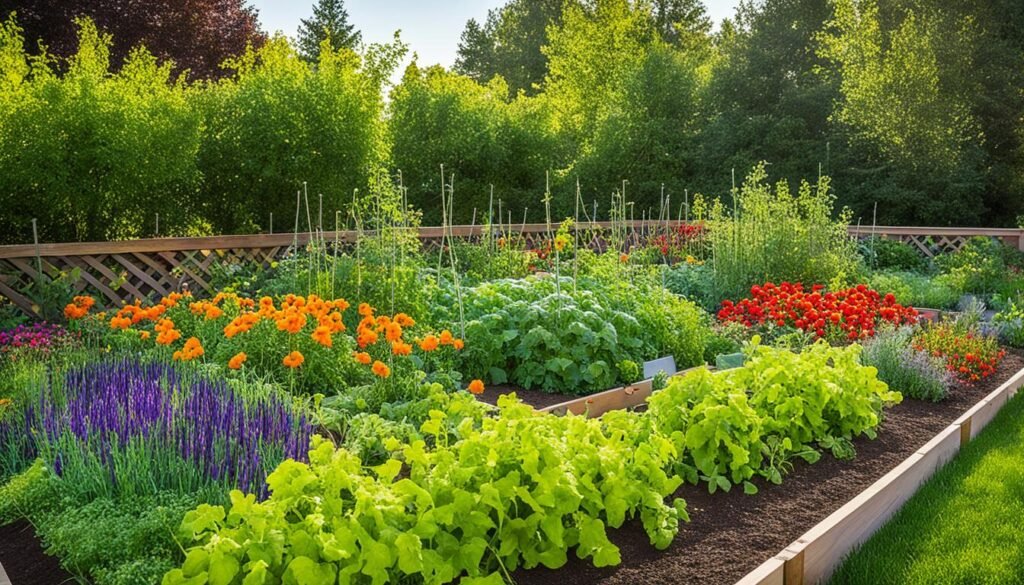
Companion planting is a smart strategy for my veggie beds. I pair plants that help each other grow and keep pests away. For example, basil near tomatoes improves their flavor and keeps insects away.
Crop rotation is another important technique. I move plant families around each season. This stops soil from getting depleted and lowers disease risks. My rotation includes:
- Leafy greens
- Root vegetables
- Fruiting plants
- Legumes
When picking vegetables, I think about my climate and space. Tomatoes, peppers, and squash love the sun. Leafy greens like lettuce and spinach do well in shade. Planning helps me get a good harvest all season.
Edible Flowers: Adding Color and Flavor to Your Yard
I adore edible blooms in my garden. They add color and flavor to any landscape. By using floral cuisine, I’ve found new tastes and textures.
Nasturtiums: Peppery Blooms for Salads
Nasturtiums are my favorite edible flowers. Their bright colors and spicy taste make salads pop. I grow them along borders or in hanging baskets. They’re easy to care for and do well in poor soil, great for busy gardeners.
Lavender: Fragrant and Versatile
Lavender is essential in my garden. Its sweet scent improves both sweet and savory dishes. I use it in teas, baked goods, and on grilled meats. Plus, its purple flowers make my garden look beautiful.
Edible Chrysanthemums: Asian-Inspired Additions
For an Asian touch, I use edible chrysanthemums. Their mild taste is perfect in stir-fries and soups. I keep them in pots near my kitchen for easy use. These flowers are a hit when I have guests over.
